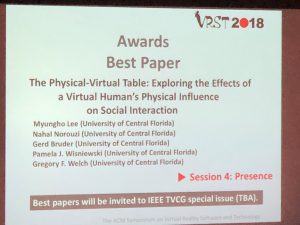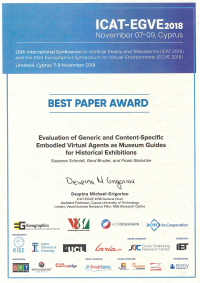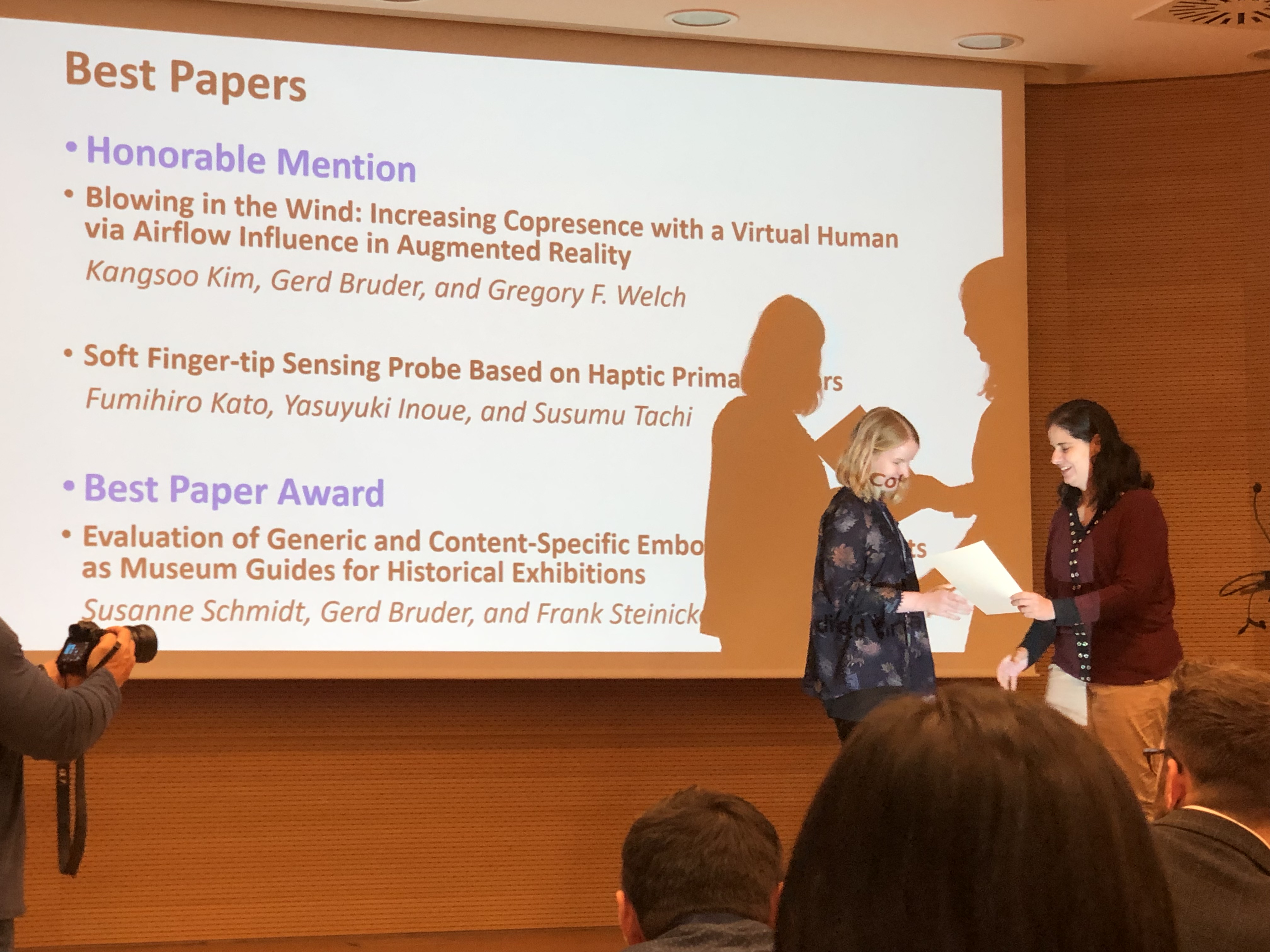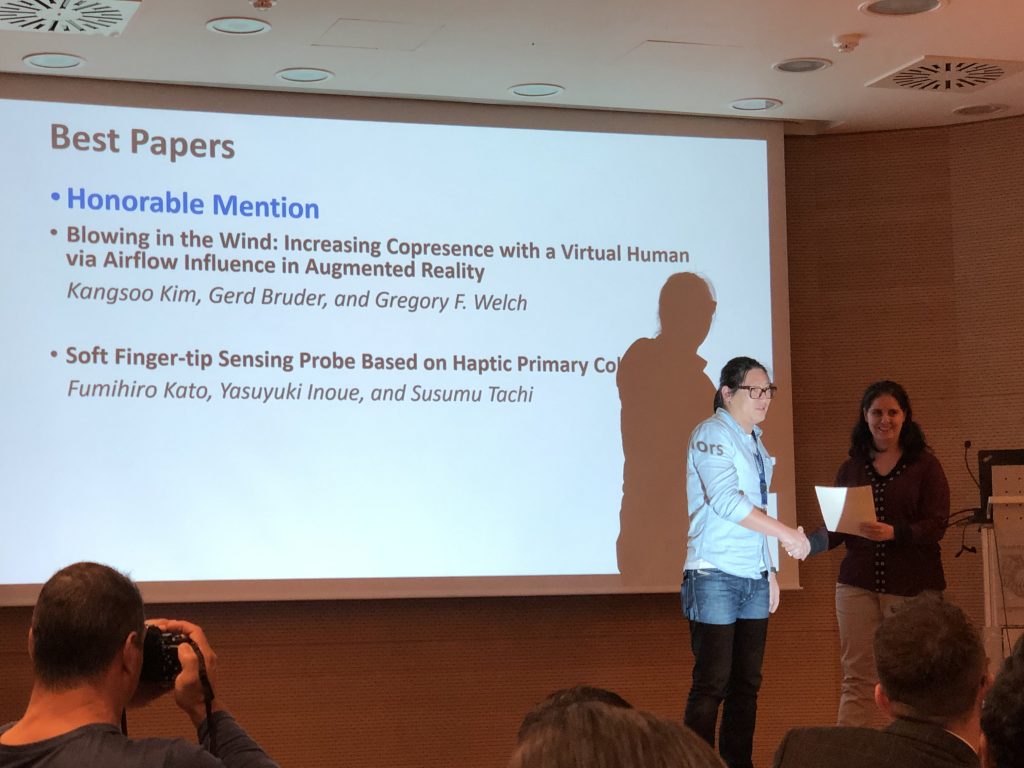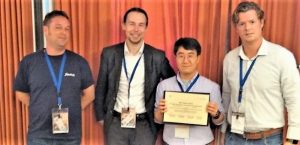Uncategorized
Salam Daher defended her PhD in Modeling and Simulation on Oct 25, 2018.
DATE and TIME: OCTOBER 25, 2018 at 1:00PM
LOCATION: UNIVERSITY TOWERS BUILDING, ROOM 604/609
MAJOR: Modeling and Simulation
TITLE: PHYSICAL-VIRTUAL PATIENT SIMULATORS: BRINGING TANGIBLE HUMANITY TO SIMULATED PATIENTS
ABSTRACT:
In lieu of real patients, healthcare educators frequently use simulated patients. Simulated patients can be realized in physical form, such as mannequins and trained human actors, or virtual form, such as via computer graphics presented on two-dimensional screens or head-mounted displays. Each of these alone has its strengths and weaknesses. I introduce a new class of physical-virtual patient (PVP) simulators that combine strengths of both forms by combining the flexibility and richness of virtual patients with tangible characteristics of a human-shaped physical form that can also exhibit a range of multi-sensory cues, including visual cues (e.g., capillary refill and facial expressions), auditory cues (e.g., verbal responses and heart sounds), and tactile cues (e.g., localized temperature and pulse). This novel combination of integrated capabilities can improve patient simulation outcomes.
In my Ph.D. work I focus on three primary areas of related research. First, I describe the realization of the technology for PVPs and results from two user-studies to evaluate the importance of dynamic visuals and human-shaped physical form in terms of perception, behavior, cognition, emotions, and learning. Second, I present a general method to numerically evaluate the compatibility of any simulator-scenario pair in terms of importance and fidelity of cues. This method has the potential to make logistical, economic, and educational impacts on the choices of utilizing existing simulators. Finally, I describe a method for increasing human perception of simulated humans by exposing participants to the simulated human taking part in a short, engaging conversation prior to the simulation.
DISSERTATION RESEARCH IMPACT:
The Physical-Virtual Patient (PVP) is a new type of patient simulators that addresses the current difficulty of representing subtle integrated multi-sensory interactive patient signs and symptoms to train healthcare providers. A better training of healthcare providers can improve patient outcomes. The PVP allows for simulating other simulators to explore the importance of different ways to present certain cues to know which aspects of representing symptoms matter and which ones do not. This can influence decisions for development and investment in simulators. I present a general method to objectively evaluate the scenario-simulator match and corresponding simulator utilization. This is relevant for a simulation center to justify investment in certain simulators, and it may help in scheduling logistics to optimize educational objectives and existing resources. Regardless of the simulator and prior to the simulation, a short exposure to an engaging conversation improves the outcomes.
ABOUT SALAM DAHER
2018-2019 Postdoc, University of Central Florida, Orlando, FL
2013-2018 Ph.D., University of Central Florida, Orlando, FL
2013-2015 M.S. University of Central Florida, Orlando, FL
2007-2012 Multimedia Software Developer, Vcom3D, Orlando, FL
2004-2006 M.S., University of Florida, Gainesville, FL
2000-2004 B.S., Lebanese American University, Byblos, LEBANON
SELECTED AWARDS & HONORS
2018 NCWIT Scholarship (awarded to 4 STEM students from 91 U.S. Universities)
2017-2018 RADM Fred Lewis I/ITSEC Scholarship (awarded to 3 PhD students)
2017 IEEE VR 2017 Doctoral Consortium (awarded to 12 PhD students internationally)
2015-2016 Link Fellowship for Modeling, Simulation and Training (awarded to 4 PhD students)
2013-2015 UCF Modeling and Simulation Scholarship (for 3 consecutive years)
Myungho Lee awarded Best Paper at VRST 2018
Gerd Bruder earned Best Paper Award at ICAT-EGVE 2018
Kangsoo Kim got an Honorable Mention Award at ICAT-EGVE 2018 in Limassol, Cyprus.
K. Kim, G. Bruder, and G. Welch, “Blowing in the Wind: Increasing Copresence with a Virtual Human via Airflow Influence in Augmented Reality,” in Proceedings of the combined International Conference on Artificial Reality & Telexistence and Eurographics Symposium on Virtual Environments (ICAT-EGVE), 2018, pp. 183–190, Limassol, Cyprus
Kangsoo Kim defended his PhD in Computer Science on Oct 30, 2018.
- Time & Location: October 30, 2018 at 3:00 PM in University Tower 650A
- Title: ENVIRONMENTAL PHYSICAL-VIRTUAL INTERACTION TO IMPROVE SOCIAL PRESENCE WITH A VIRTUAL HUMAN IN MIXED REALITY
- Abstract: Interactive Virtual Humans (VHs) are increasingly used to replace or assist real humans in various applications, e.g., military and medical training, education, or entertainment. In most VH research, the perceived social presence with a VH, which denotes the user’s sense of being socially connected or co-located with the VH, is the decisive factor in evaluating the social influence of the VH-a phenomenon where human users’ emotions, opinions, or behaviors are affected by the VH. The purpose of this dissertation is to develop new knowledge about how characteristics and behaviors of a VH in a Mixed Reality (MR) environment can affect the perception of and resulting behavior with the VH, and to find effective and efficient ways to improve the quality and performance of social interactions with VHs. Important issues and challenges in real-virtual human interactions in MR, e.g., lack of physical-virtual interactivity, are identified and discussed through several user studies incorporating interactions with VH systems. In the studies, different features of VHs are prototyped and evaluated, such as a VH’s ability to be aware of and influence the surrounding physical environment, while measuring objective behavioral data as well as collecting subjective responses from the participants. The results from the studies support the idea that the VH’s awareness and influence of the physical environment can improve not only the perceived social presence with the VH, but also the trustworthiness of the VH within a social context. The findings will contribute towards designing more influential VHs that can benefit a wide range of simulation and training applications for which a high level of social realism is important, and that can be more easily incorporated into our daily lives as social companions, providing reliable relationships and convenience in assisting with daily tasks.
- Major: Computer Science
- Educational Career:
- Bachelor’s of Electronics and Computer Engineering, BS, 2009, Hanyang University
- Master’s of Electronics and Computer Engineering, MS, 2011, Hanyang University
- Master’s of Computer Science, MS, 2015, University of Central Florida
- Committee in Charge:
- Gregory Welch, Chair, Computer Science
- Avelino Gonzalez, Computer Science
- Gita Sukthankar, Computer Science
- Stephen Fiore, Philosophy
- Gerd Bruder, Computer Science
- Jeremy Bailenson, Communication, Stanford University
Nice NASA article on M&S alum Angelica Garcia
Nice story from a few months ago highlighting work by Angelica Garcia (link), M&S Alum, advisee of ours, and friend.
Prof. Welch to serve on WEF Council on VR/AR
Prof. Welch will serve one year on the World Economic Forum, Global Future Councils, Council on Virtual and Augmented Reality. Collaborator Prof. Jeremy Bailenson (Stanford) is a Co-Chair of the Council.
Sungchul got Best Paper Award at ACM SUI 2018 in Berlin
Five full papers are accepted at ICAT-EGVE 2018.
Susanne Schmidt, Gerd Bruder, and Frank Steinicke; Evaluation of Generic and Content – Specific Embodied Virtual Agents as Museum Guides for Historical Exhibitions
Paul Lubos, Gerd Bruder, and Frank Steinicke; SafeWalking Zones: Visual Guidance for Redirected Walking in Confined Real-World Spaces
Ryan Schubert, Gerd Bruder, and Gregory Welch; Adaptive Filtering of Physical-Virtual Artifacts for Synthetic Animatronics
Gregory Welch, Tianren Wang, Gary Bishop, and Gerd Bruder; A Novel Approach for Cooperative Motion Capture (COMOCAP)
Kangsoo Kim, Gerd Bruder, and Gregory F. Welch; Blowing in the Wind: Increasing Copresence with a Virtual Human via Airflow Influence in Augmented Reality

